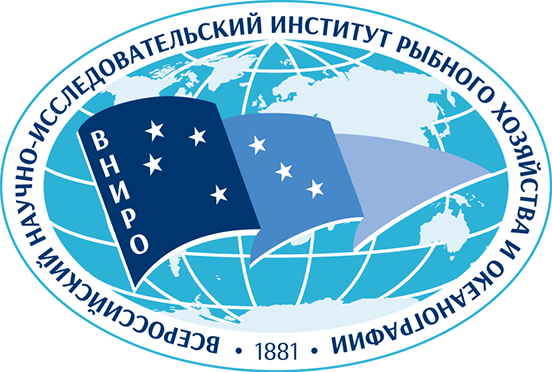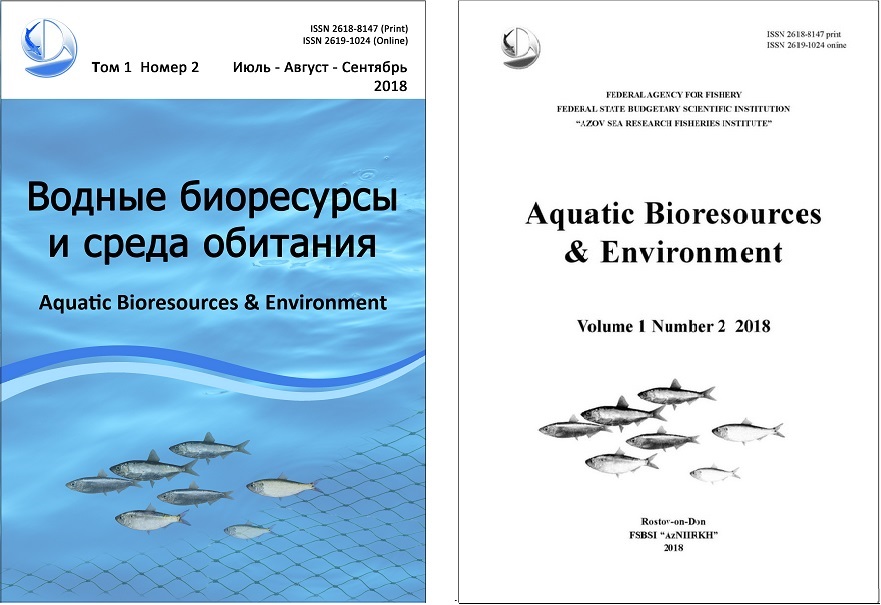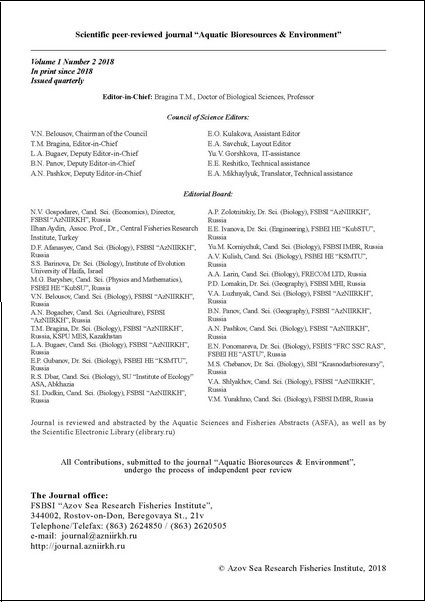Год / Year
2018
90 years of the Azov Sea Research Fisheries Institute
Environmental Concerns and the State of the Aquatic Environment
Inter-annual variability of the water temperature in the Azov Sea and its regions in the summer season of 1992–2016
Kochergin A.T.
Abstract. The range of inter-annual variability of the sea surface temperature (SST) in the Azov Sea (excluding the Taganrog Bay), as well as changes in its inter-annual course and the trends and repeating patterns it displayed, were studied and analyzed. The data for the research studies were provided by the expeditions carried out by AzNIIRKH (Rostov-on-Don) in the summer season (July–August) of 1992–2016. Two dissimilar periods, before 2005 and after, with differing measures of variability in the sea surface temperature, were established. The SST in the first period was characterized by relatively wide range of variability, by low values of the SST in all regions at the beginning of the research and its subsequent increase in the 1990-s, by prevailing synchronicity of the variability, and by vastly differing repeating patterns (2–7 years). The SST in the second period was characterized by relatively small range of variability, remaing at the level +24 °С or higher, by asynchronicity of the inter-annual variability, especially before 2013, and by a narrow range of repeating patterns (2–5 years). Some of the reasons for such differentiation are described.
Keywords: Azov Sea, sea surface temperature, trend, long-term records
Biology and Ecology of Aquatic Organisms
On immunophysiological status of the Black Sea turbot Scophthalmus maeoticus maeoticus at different reproductive stages
Boyko N.E., Ruzhinskaya L.P.
Abstract. Results of the long-term studies of the nonspecific immunity factors in the turbot breeders from th e north-eastern part of the Black Sea during the pre-spawn, spawning and post-spawn periods are presented. Data on leukocyte composition, lysozyme, immunoglobulins and immune complexes of the blood serum were obtained. It is shown that, in natural conditions, the activity level of the cellular and humoral components of immunity is determined by annual rhythms associated with maturation of the sexual products and the temperature conditions of the medium. Turbot peripheral blood leukocytes are mainly represented by lymphocytes and neutrophils, the latter ones showing predominance of stab neutrophils in the composition. During the spawning period, the fraction of neutrophils in the turbot white blood decreases, as well as the fraction of stab cell forms in th e neutrophil composition (in females). Sex differences in the state of humoral immunity are found in breeders dur ing the spawning period, and they are obvious due to certain indicators. Before spawning, immunophysiological status of both females and males is normally achieved by high concentrations of lysozyme and immunoglobulins. In the active phase of the cycle, a decrease in the content of lysozyme and immunoglobulins and an increase in the content of immune complexes were recorded in the blood serum of females. In the turbot males, the completion of its reproduction cycle is characterized by an increase in lysozyme, a decrease in immunoglobulins and by stable values of immune complexes.
Keywords: Scophthalmus maeoticus maeoticus, Black Sea, commercial species, reproduction cycle, blood, leukocytes, lysozyme, immunoglobulins, immune complexes
Status of the veined rapa whelk Rapana venosa (Valeciennes, 1846) population in the north-eastern Black Sea
Saenko E.M., Marushko E.A.
Abstract. Based on the results of long-term expeditions carried out to assess the state of Rapana venosa population in the north-eastern Black Sea, some negative changes in the rapa whelk population caused by poor tr ophic conditions were revealed: their density, biomass and the number of age groups decreased and length and weight parameters declined. The distribution density of the rapa whelk in the biotope and the dynamics of its biomass are found to have changed during the studied period, while the distribution was of a mosaic nature and determined by the trophic supply of the bottom biocenosis. Dynamics analysis of the density and biomass of R. venosa put together with the physiological indices (fatness factor, relative shell thickness) showed their interannual fluctuation in 2011–2015. The results obtained indicate that the current state of R. venosa should be considered as permamently depressed. The population suffers an acute shortage of food organisms, moreover, high food competition is observed within the species. Under these conditions, the population of R. venosa is represented by a large number of small-sized individuals which are of no interest to commercial fishing.
Keywords: veined rapa whelk, Rapana venosa, Black Sea, density, biomass, population structure, condition factor, bivalve molluscs, trophic resources
Aquaculture and Methods of Artificial Reproduction
Characteristics of roach Rutilus rutilus (L.) juveniles, reared at the flood-plain hatching and rearing fish farms of the Azov-Kuban Region in 2017
Sergeeva S.G., Voikina A.V., Tsybulskaya M.A., Bugaev L.A., Pavlyuk A.A., Gorbenko E.V., Poluvyanov P.N.
Abstract. In 2017, the status of flood-plain hatching and rearing fish farms in the Azov-Kuban Region (the Beysug hatchery and the Yeysk experimental farm for fish breeding and rearing) was studied. In order to assess the influence of environmental conditions on spawning efficiency and adaptation of roach juveniles, hydrological, hydrochemical and hydrobiological features of the reservoirs for fish spawning and growing were investigated. It is shown that the water temperature changed in accordance with the climatic conditions of the region, which came with typical accumulation of spring heat and the presence of decreases in temperature in May an d June. The content of the dissolved oxygen ranged from 2.7 to 9.0 mg/l. During the period of rearing at the Beysug hatchery and the Yeysk experimental farm, the biomass of fodder zooplankton varied significantly, which indicates the formation of different feeding conditions in the reservoirs. Analysis of the morphometric and physiological parameters of the roach at different stages of their larval and fry development (from the B stage to downstream migration) gives evidence of considerable variability in the juveniles, which may be both due to feeding conditions in the water bodies and to the long spawning of breeders. It was found out that 14 % of the examined larvae showed some abnormalities at developmental stages C2–E. By the end of the rearing period, most roach juveniles were of good quality; their characteristics corresponded to the standard values, which made it possible to predict their high survival rate. The length and weight of the even-aged juveniles from the two basins of th e Beysug hatchery are shown to be different, which was affected by the different environmental conditions in these water bodies.
Keywords: Rutilus rutilus, hatching farm, rearing fish farm, roach, larvae, juveniles, developmental stages, food resources, hydrochemical parameters, morphometry, fish physiology
CONTENT
Fisheries and Processing of Aquatic Bioresources
Fishing pressure for vessels of different power capacity during anchovy trawling in the Azov and Black Seas Basin in 2017
Stafikopulo A.M., Gorbatyuk Ya.I.
Abstract. Factors, determining fishing parameters, were studied and analysed; these factors include technical specifications of vessels, engaged in fishing, their equipment and fishing gear, time expenditures for fishing operations, fishing conditions, fishing intensity, trawling time and speed, capacity and synergy of fishing systems, etc. Daily vessel activity reports on anchovy fishing in 2017 were processed, and, based on the obtained data, the most relevant fishing parameters were calculated for vessels of different power capacity: fishing effort, catch per unit effort and fishing pressure. Comparative analysis of five types of vessels, involved in the anchovy trawl fishery in the Azov and Black Seas Basin, was made. The considered types of vessels were the following: medium fishing freezer trawler (10 vessels), small-size fishing trawler (3), receiving and transporting refrigerator (13), TKHS type refrigerated fish carrier (1), refrigerating fishing seiner-trawler, i.e. medium Black Sea seiner, (12). The analysis of fishing pressure parameters for vessels of various types can be applied in fisheries regulation, in case of changes in the resource availability, fish stock assessment, as well as improvement and renovation of fishing systems.
Keywords: Azov and Black Sea Fishery Basin, fishing fleet, types of vessels, anchovy, fishing effort, fishing pressure, midwater trawl
International Cooperation
The Convention for the Conservation of Antarctic Marine Living Resources and management problems
Kukharev N.N., Zaytsev A.K.
Abstract. In 1982, based on the Antarctic Convention, the international organization — Commission for the Conservation of Antarctic Marine Living Resources (CCAMLR) — was founded, which is, according to the United Nations Convention on the Law of the Sea, a regional organization, aimed at fisheries management and invested with enhanced authority on the issues of the Antarctic ecosystem conservation. CCAMLR regulates fisheries by implementing the Conservation Measures (CMs). They are developed by the Scientific Committee with regard to results of scientific observations and programs, models and simulations, and recommen dations from the Working Groups. The Measures are adopted by the delegations from member states annually and only after consensus of opinions. Current yield from fishing and harvesting operations in the Antarctic amounts to 279,000 t (2016), including 260,000 t of krill, 12,000 t of the Patagonian toothfish, 4,000 t of the Antarctic toothfish, 600 t of the mackerel icefish, and 2,400 t of by-catch (macrouruses and antimora). Fishing and harvesting operations are carried out (in descending order) by Norway, the People's Republic of China, the Republic of Korea, Ukraine, France, Chile, Australia, Great Britain, New Zealand, Russia, Spain, the Republic of South Africa, Uruguay, Japan. All fishing and harvesting sites are located in the areas, covered by territorial claims of the states of the region. So far CCAMLR has been applying precautionary approach instead, in which precautionary criteria are derived from modeling, inferences and assumptions. Over 20 non-governmental organizations, collaborating with CCAMLR, influence the content of the Measures: Antarctic and Southern Ocean Coalition, Environmental Protection Committee, International Union for Conservation of Nature and Natural Resources, etc. CCAMLR current system of management is basically politically motivated, oriented on minimization of fishing and harvesting operations, and proclamatory conservation of the ecosystem. From 1989 to 2017, CCAMLR member states agreed to shut down fishing operations in 70 % of productive areas, limited fishing operations on icefishes and the Antarctic toothfish down to minimum, banned fishing of cod icefishes (notothens), Electron subantarctic lanternfish and other species. Since 2005, on the pretext of the recommendations of the World Summit on Sustainable Development in Johannesburg (2002), the programs on creating of the Marine Protected Areas (MPAs) network in the Antarctic were imposed on CCAMLR by its member states — Great Britain, the USA, Australia, New Zealand, and France. Those MPAs were meant to cover the area of millions of sq. km, to be located in the waters, adjacent to the sectors of their territorial claims in the Antarctic, and to be put under their own control. It was intended to create an MPA under the control of New Zealand, located in the Ross Sea Region, where fishing operations on the Antarctic toothfish are carried out, and in the adjacent waters, including the section of the Antarctic Circumpolar Current. Russia, Ukraine and several other countries vetoed creation of this MPA, due to the absence of scientific substantiations for it, and also for the reason that such handover of the sites in the open seas of the World Ocean under the control of any state is not stipulated by the Antarctic Convention. A compromise was reached in 2016 by means of creation of a new MPA under the CCAMLR authority, under the condition that there would be assigned a site, where fishing operations can be carried out, yielding catch on the level with the previous years. Thus, the conclusion can be drawn that CCAMLR is developing the ideas of creating the MPA network around Antarctica, where fishing operations could be limited. However, by creating the MPA in the Antarctic open seas and intending to protect it, CCAMLR member states exceeded the legal bounds of the Antarctic Convention, which does not provide for conservation and protection of aquatic areas and biota, including creation of MPAs. Change in CCAMLR regulatory policy to creation of the MPA network in the Antarctic is aimed at positive response of international non-governmental conservational organizations and global community. That being said, there exist well-grounded doubts that an MPA makes it possible to maintain species diversity, functional roles and biomass of hydrobionts, particularly in the regions with continuous anthropogenic pressure, as well as under the conditions of such intense hydrological processes as the Antarctic Circumpolar Current. It seems obvious that, in case the plans of the CCAMLR member states (the MPA supporters) on covering the major part of the Antarctic waters with such MPAs are realized, the catches will have to be brought down to minimum, and any fisheries development in the Antarctic will be considered impossible; its vast biological resources will be unavailable for humanity.
Keywords: Antarctic, CCAMLR, ecosystem, precautionary approach, Conservation Measures, fishery management
Informational Messages
Periodicals and librarianship of the Azov Sea Research Fisheries Institute
Bragina T.M., Kulakova E.O., Reshitko E.E., Sokolova O.I.
Abstract. The history of the Federal State Budgetary Scientific Institution “Azov Sea Research Fisheries Institute” (FSBSI “AzNIIRKH”) dates back to the Rostov Branch of the Don-Kuban Scientific Fisheries Station, established in 1928. In 2018, FSBSI “AzNIIRKH” celebrates its 90th anniversary. Currently, the institute has become a leading fishery organization in the South of Russia, which also includes the Southern Research Institute of Marine Fisheries and Oceanography (YugNIRO), Krasnodar Research Fisheries Institute (since 2008 — Krasnodar part of the All-Russian Research Fisheries and Oceanography Institute) and monitoring stations in the south of Russia. Federal State Budgetary Scientific Institution “AzNIIRKH” conducts extensive research, monitoring and stock assessment activities in the Azov and Black Seas Fishery Basin, in the Atlantic and Indian Oceans. The first periodical of the Institute was “Works of Don-Kuban Scientific Fishery Station”, published from 1934 to 1941. Currently “Proceedings of AzNIIRKH” are a regularly institute periodical, indexed in the base of the National Electronic Library (e-library.ru). In 2018, the first issue of the scientific peer-reviewed journal “Aquatic Bioresources and Environment” was published.
Keywords: periodicals, scientific reviewed journals, fishery institutions, Azov Sea Research Fisheries Institute
To the 80th birth anniversary of Nonna Iosifovna Kulikova, outstanding scientist, who made a significant contribution into the development of national mariculture
Bulli L.I.
Abstract. Kulikova Nonna Iosifovna (09.06.1938 – 02.02.2018) was Candidate of Biological Sciences, Senior Researcher, Head of the YugNIRO Laboratory of Fish Physiology (from 1972 to 1992), leading scientist of the same laboratory, talented scholar, manager, physiologist and biochemist. N.I. Kulikova made a huge contribution into the scientific research, aimed at development of biological grounds and biotechnology of artificial reproduction for marine fish, primarily mullets and flounders, which are valuable commercial species of the Azov and Black Sea Basin. For many years, N.I. Kulikova was a coordinator and executive in charge of government programs, funded from the state budget; they involved the development of scientific bases for marine fish culture and for reproduction of mullets and flounders, as well as methods of controlling the growth, maturation and spawning of broodstocks, and theoretical background for control over life cycles of valuable marine species. She worked on creation of hatcheries and rearing farms for stocking of natural water bodies and for commercial culture. Alongside with her colleagues, she was able to solve a range of problems, concerning the development of mullet cultivation. As the result of her long-term research, the practices of hormonal stimulation of breeders, belonging to the Black Sea mullet species and to the so-iuy mullet, introduced from Far East, were developed, as well as methods for controlling early ontogenesis. She studied feeding ecology and feeding requirements of larvae and early juveniles, and worked out some stages of biological technology for reproduction of three mullet species. Nonna Iosifovna is the author of numerous scientific papers, including the monography “Mariculture of fish and its development prospects in the Black Sea Basin”, guidelines, patents, scientific substantiations for creating hatcheries for marine fishes.
Keywords: Nonna Iosifovna Kulikova, biotechnology, artificial reproduction, mullets, flounders, patents, hatcheries




